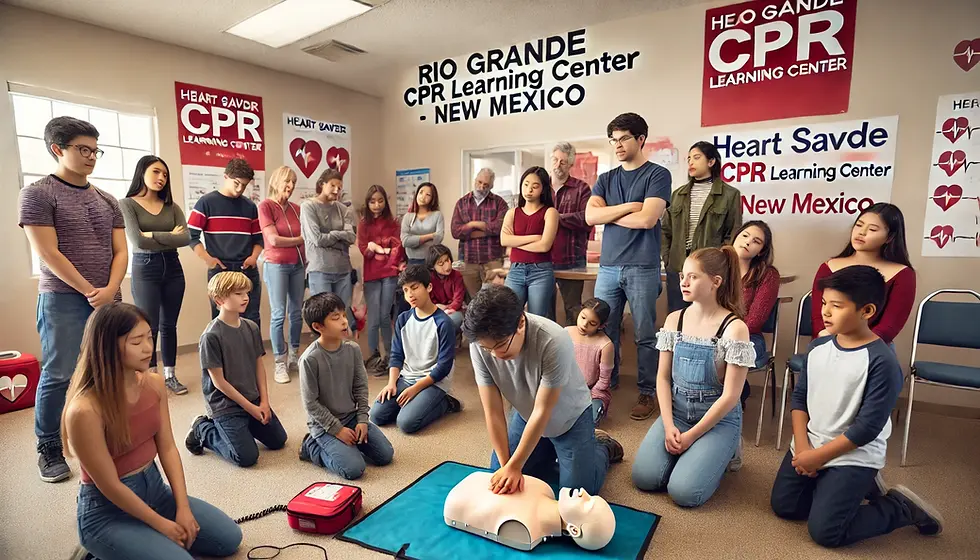The Lifesaving Importance of CPR Training in Business Environments: Be Prepared for Emergencies in Any Setting
- America Kelleher
- Mar 15
- 3 min read
In any business setting, the health and safety of employees are critical. Emergencies can arise without any warning, and it is essential to be prepared. Sudden cardiac arrest (SCA) is one of the most serious health emergencies that can occur unexpectedly, leaving little time to react. That's why having staff trained in Cardiopulmonary Resuscitation (CPR) is vital in all industries—whether it’s in an office, a retail store, a construction site, or a restaurant. CPR is a lifesaving skill that anyone can master and can make the difference between life and death.
Why CPR Training is Vital for Business Settings
Sudden cardiac arrest can happen anywhere—at work, home, or out in public. In business environments, employees often become the first responders before medical personnel can arrive. Knowing CPR can significantly enhance the chances of survival for a colleague or customer in need.
For example, studies show that immediate CPR can double or even triple a person’s chance of survival from a cardiac arrest. In large organizations, having even a small percentage of trained individuals can result in more lives saved.
Investing in CPR training not only promotes a safer workplace but also nurtures a culture of preparedness and accountability among employees.
CPR in Office Environments
Heart attacks or sudden cardiac arrests can strike at the most unpredictable times, even during a routine office day. Whether in a conference room, cubicle, or break room, employees trained in CPR can ensure that immediate action is taken.
In an office, the distance from exit points can hinder help. Quick action from a trained employee can save critical seconds. For instance, if a colleague collapses, initiating CPR within the first few minutes can lead to significantly better outcomes.
Equipping employees with the skills to respond effectively steers them away from panic and chaos. When staff are confident in their CPR abilities, they are more likely to stay calm and focused, which is crucial in emergencies.
CPR in Retail and Hospitality
Retail and hospitality settings experience constant customer traffic, making them vulnerable to health emergencies. Staff trained in CPR can respond promptly, providing essential assistance until medical help arrives.
For example, if a customer suddenly collapses in a store or restaurant, trained staff can react immediately. Statistics indicate that, in such scenarios, every minute counts. By acting quickly, businesses may transform a potential tragedy into a success story.
Moreover, prioritizing safety can enhance a business's reputation. Customers are more likely to trust establishments that visibly value health and safety.
CPR in Construction Sites
Construction sites come with inherent dangers, where workers face physical challenges that can increase the risk of heart-related emergencies. Having CPR-trained personnel on site can literally be the difference between life and death.
For example, a worker suffering a heart attack on-site has a higher chance of survival if someone trained in CPR is nearby. Regular CPR training sessions should be an integral part of the health and safety programs for construction workers.
By doing this, businesses reinforce their commitment to their employees' safety, significantly reducing the chances of fatal health emergencies.
CPR Training Programs: Key Considerations for Businesses
Organizations planning to implement CPR training should consider a few essential elements:
Qualified Instructors: Opt for certified instructors who can deliver effective CPR training, ensuring employees learn the most current techniques and guidelines.
Regular Training Sessions: Conduct training sessions consistently. Research shows that skills can decline over time, so refresher courses keep employees prepared and engaged.
Including First Aid and AED (Automatic External Defibrillator) training can further enhance the readiness of staff in case of emergencies. Promoting safety as a core value within the organization also encourages more employees to participate, creating a supportive community focused on health and safety.

The Impact of CPR Training in Your Workplace
The significance of CPR training in business environments is immense. Emergencies can emerge unexpectedly, and trained staff can drastically enhance the survival rates of those affected.
Whether in offices, retail outlets, or construction sites, the prompt response of a CPR-certified employee can change the outcome of a crisis. By investing in CPR training, businesses not only prepare their workforce for emergencies but also demonstrate a strong commitment to the health and safety of their employees and customers.
Every minute is crucial during an emergency. Equipping staff with lifesaving skills is a proactive step toward creating a safer environment, ensuring that help is always within reach.
Promoting a culture of readiness through CPR training not only saves lives but also strengthens relationships among employees as they collaborate for safety. In any setting—office, store, construction site, or restaurant—be prepared. You never know when your training might mean the difference between life and death.




Comments